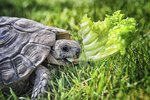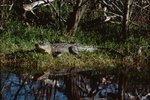
Sideneck turtles are bizarre animals that look lopsided thanks to their unusual neck anatomy. Also colloquially referred to as helmeted, mud or musk turtles, sideneck turtles have not been studied extensively, nor are they kept in captivity very often. Keepers searching for uncommon turtle pets should consider sideneck turtles, but be careful to choose a species that remains a manageable size.
Classification
Sideneck turtles, a group called the Pleurodira, are represented by two families: Pelomedusidae and Chelidae. Together, they account for 66 described species in 16 genera. While no Chelidae species reside in Africa -- they're indigenous to South America, Australia and New Guinea -- most of the Pelomedusidae are found there -- approximately 16 species of sideneck turtle are native to Africa.
Biology
The sideneck turtle gets its name because of the way it retracts its head; rather than withdrawing the head straight back like most turtles do, sideneck turtles fold their necks sideways. Much of the natural history and ecology of the group is poorly understood, though the majority of species are thought to be carnivorous. Reports exist of some Palomedusa species eating the ectoparasites off of rhinoceroses that entered the water as well as “pack-hunting” birds that enter the water. At least one species, the East African sideneck turtle (Pelusios subniger), is thought to be nocturnal, which is somewhat rare for turtles. Pelomedusids, like all turtles, deposit eggs that are buried in soft sand substrate. Some Pelomedusa species are semi-aquatic and will inhabit temporary bodies of water; when the water dries up; the turtles burrow into the mud and await the return of the rains.
Size
The size of African sideneck turtles varies by species and gender; females likely reach larger sizes than males. African dwarf mud turtles (Pelusios nanus) don’t even reach 5 inches in length, but most species are larger than this. Most African helmeted turtles (Pelomedusa subrufa) and East African sideneck turtles are less than 8 inches in length, but a male helmeted turtle captured in 1941 measured almost 13 inches long. The East African serrated mud turtle (Pelusios sinuatus) is often available to hobbyists, but reaches very large sizes. By five or six years of age, most females will have reached 9 to 12 inches in length. Eventually, large females may exceed 20 inches in length.
Habitat Size
Sideneck turtles require semi-aquatic habitats with plenty of space for burrowing. The water area for the turtles should be at least five times the length of the turtle, the water portion’s width should be three times the length of the turtle and the depth should be at least twice the turtle’s length. The land area should be about the same size. For example, a 10-inch helmeted turtle requires a water area of approximately 100 gallons and a 4-foot by 2-foot land area filled with a dirt or mulch substrate. It's important that both areas are escape-proof and protected from predators if the cage is outdoors.
References
- Animal Diversity Web: Pelomedusidae
- Animal-World: African Side-Necked Turtles
- Animal Diversity Web: Chelidae
- Arkive: East African Mud Turtle
- Empire of the Turtle: Pelomedusa S. Subrufa
- ETI Bioinformatics: Pelomedusa Subrufa
- Melissa Kaplan's Herp Care Collection: Reptile Housing: Size, Dimension and Lifestyle
Photo Credits
-
Jupiterimages/Photos.com/Getty Images




